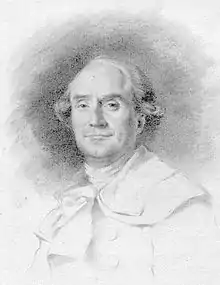Michel Paul Guy de Chabanon
Michel-Paul Guy de Chabanon (1730, Saint-Domingue – 10 June 1792, Paris) was a violinist, composer, music theorist, and connoisseur of French literature. He was elected to the Académie des inscriptions et belles-lettres (1760) and the Académie française (1779).[1]
Michel Paul Guy de Chabanon | |
|---|---|
 | |
| Born | 1730 Saint-Domingue (now Haiti) |
| Died | 10 June 1792 |
| Occupation | Violinist, composer, writer |
Biography
As fiction writer
Michel Paul Guy de Chabanon wrote poetry, elegies (notably that of Rameau), plays (including the tragedy of Éponine) and translations (adjudged by the 19th century Dictionnaire Bouillet as having "little fidelity [to the original text], but not lacking in elegance and facility").
As musician and music theorist
Michel Paul Guy de Chabanon was also a successful musician, playing the violin in the Concert des Amateurs under the direction of Joseph Bologne, chevalier de Saint-Georges.[2]
He was the author of an opera, Sémélé, tragédie lyrique, and of several works on music theory, of which the most valued are his commentaries on music in the work of Aristotle .[3] His double identity as a writer and a musician gave him a unique viewpoint on the links between music and language and in developing a philosophy of music of which his work was the expression. He also contributed to defining opera as a musical genre.[4]
Works
Works on music esthetics
- 1779 : Observations sur la musique, et principalement sur la métaphysique de l'art (Paris, 1779; translated by Weber in German as Ueber die Musik und deren Wirkungen, aus dem franz. übersetzt mit Anmerkungen, Leipzig, 1781)
- 1785 : Sur l'introduction des accords dans la musique des anciens, Mémoire
- 1785 : De la musique considérée en elle-même et dans ses rapports avec la parole, les langues, la poésie, et le théâtre (Paris, )1785).
Libretti
- Sabinus (1773)
References
- Académie française
- "Such was Chabanon, who was in the Académie française and Académie des inscriptions, who played the violin very well, and who was second violin in the concert des amateurs, of which Saint-George was leader – François-Joseph Fétis, Revue musicale [archive : XIXe siècle, Published by F. J. Fétis, Paris, 1829.
- "In the 46th volume of his "Mémoires de l'académie des inscriptions et belles-lettres de Paris", Chabanon gave a French translation of Aristotle's problems relating to music, with a commentary in which he clarifies the sense, generally very obscure. Chabanon's three mémoires extend from page 285 to 335." – François-Joseph Fétis, Biographie universelle des musiciens et bibliographie générale de la musique : XIXe siècle, Published by Leroux, Paris, 1835. Notice Bnf n° FRBNF30432155
- Deux visionnaires au siècle des Lumières : Michel-Paul-Guy de Chabanon (1730–1792) et Christoph Willibald Gluck (1714–1787)
 Bouillet, Marie-Nicolas; Chassang, Alexis, eds. (1878). Dictionnaire Bouillet (in French).
Bouillet, Marie-Nicolas; Chassang, Alexis, eds. (1878). Dictionnaire Bouillet (in French). {{cite encyclopedia}}: Missing or empty|title=(help)